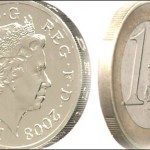Gold drifted further away from a six-week high touched earlier in the week, pressured by a strong dollar and better-than-expected manufacturing data from the Eurozone, which sparked some confidence about the single currency blocs economy.
Comex gold for delivery in December fell by 0.44% to $1 240.0 per troy ounce by 8:45 GMT, having shifted in a daily range of $1 244.9-$1 238.9 an ounce. The precious metal fell 0.5% to $1 245.5 on Wednesday, moving away from Tuesdays six-week high of $1 255.6 an ounce.
Gold prices were pressured as the US dollar strengthened following recent upbeat data from the US. Better-than-expected manufacturing numbers from Germany and the Eurozone as a whole eased fears about the single currency blocs economic state, curbing safe-haven demand.
Last week’s upbeat industrial production, initial jobless claims and housing starts in the US, coupled with Tuesday’s better-than-expected September existing homes sales fueled confidence among investors the US economic recovery remains robust and on track. Firmer-than-expected consumer inflation data on Wednesday also strengthened the dollar.
The US dollar index, which measures the greenback’s performance against a basket of six major peers, rose to a 1-week high on Thursday. The December contract stood at 85.855 at 8:48 GMT, unchanged on the day, having earlier risen to 86.025, the highest since October 15th. The US currency gauge rose 0.53% on Wednesday to 85.854, the highest settlement in a week and a half.
In Europe, a preliminary gauge showed activity in Frances manufacturing and services sectors contracted more than projected in October, but much better-than-expected manufacturing numbers from Germany helped offset it. The Eurozone as a whole saw its Markit Flash Eurozone Purchasing Managers Index rise to a two-month high of 50.7, up from Septembers final reading of 50.3, while factory output surged to the highest in three months with the Flash Eurozone Manufacturing PMI Output Index hitting 51.9.
China manufacturing
Chinas preliminary manufacturing gauge also came in better-than-projected, but it failed to dismiss concerns over a slowdown in the worlds second-biggest economy, stoking speculations for the introduction of additional monetary measures.
The flash HSBC Flash China Manufacturing PMI registered at 50.4 in October from 50.2 in September, exceeding analysts’ projections for a jump to 50.3. The Manufacturing Output Index, however, fell to 50.7 from 51.3 in September. Both employment and inventory indices improved, but disinflation pressures intensified.
“While the manufacturing sector likely stabilized in October, the economy continues to show signs of insufficient effective demand,” said Hongbin Qu, Chief Economist, China & Co-Head of Asian Economic Research at HSBC said. “This warrants further policy easing and we expect more easing measures on both the monetary as well as fiscal fronts in the months ahead.”
Physical demand
The precious metal, however, remained underpinned by strong physical demand from No2 consumer India. The Asian country celebrated Dhanteras, the biggest gold-buying festival, on Tuesday, while Diwali, the festival of lights, is celebrated today. October 23rd and 24th are public holidays in India. According to estimates by the All India Gems & Jewellery Trade Federation, India’s gold imports probably jumped to 95 tons last months from 15-20 tons a year earlier, while researcher CPM Group estimates the holiday generates around 20% of annual purchases.
However, long-term sentiment on gold remained bearish as the Fed is broadly expected to end its QE program at its October meeting, while an interest rate hike is anticipated to come at some point in 2015.
Assets in the SPDR Gold Trust, the biggest bullion-backed ETP and a proxy for investor sentiment towards gold, fell by 0.3% to 749.87 tons on Wednesday, the lowest since November 2008.
Market players now eyed Thursdays initial jobless claims from the US, as well as the preliminary manufacturing PMI and Augusts house price index for further clues regarding the US economys recovery state.
Elsewhere on the precious metals market, silver for delivery in December slid 0.59% to $17.130 per ounce by 8:45 GMT after it fell 1.8% to $17.231 on Wednesday, the lowest settlement since October 8th. Platinum January futures shed 0.86% to $1 260.2 an ounce, a second day of losses, while palladium for delivery in December fell by 1.48% to $765.20 an ounce, its first decline in five days.
Pivot points
According to Binary Tribune’s daily analysis, December gold’s central pivot point on the Comex stands at $1 245.5. If the contract breaks its first resistance level at $1 250.2, next barrier will be at $1 255.0. In case the second key resistance is broken, the precious metal may attempt to advance to $1 259.7.
If the contract manages to breach the first key support at $1 240.7, it may come to test $1 236.0. With this second key support broken, movement to the downside may extend to $1 231.2.





